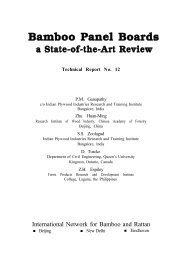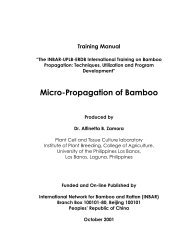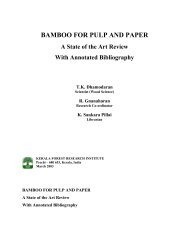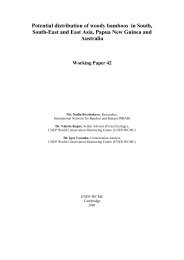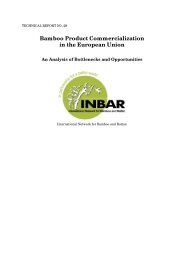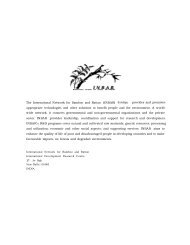The Bamboo and Rattan Sectors in Asia: an Analysis of ... - INBAR
The Bamboo and Rattan Sectors in Asia: an Analysis of ... - INBAR
The Bamboo and Rattan Sectors in Asia: an Analysis of ... - INBAR
Create successful ePaper yourself
Turn your PDF publications into a flip-book with our unique Google optimized e-Paper software.
that they might be able to get for their produce would be unlikely to compensate the<br />
<strong>in</strong>cremental costs <strong>of</strong> mak<strong>in</strong>g the sale. <strong>The</strong>refore, collectors <strong><strong>an</strong>d</strong> growers are will<strong>in</strong>g to<br />
accept the terms <strong>of</strong>fered by traders, as long as the price is higher th<strong>an</strong> their opportunity<br />
cost. In m<strong>an</strong>y cases, where opportunities are so limited, this me<strong>an</strong>s that <strong>in</strong> actual<br />
terms they are satisfied with <strong>an</strong>yth<strong>in</strong>g better th<strong>an</strong> break-even prices. <strong>The</strong> same logic<br />
applies at tr<strong>an</strong>sformation po<strong>in</strong>ts higher up the PCS.<br />
<strong>The</strong> same pressures that drive large-scale traders <strong><strong>an</strong>d</strong> m<strong>an</strong>ufacturers to establish<br />
contract relationships with suppliers have also led to true vertical <strong>in</strong>tegration,<br />
especially <strong>in</strong> the ratt<strong>an</strong> sector. In Indonesia, m<strong>an</strong>y East Java furniture m<strong>an</strong>ufacturers<br />
are also exporters <strong><strong>an</strong>d</strong> own semi-process<strong>in</strong>g factories <strong>in</strong> Sulawesi. In the Philipp<strong>in</strong>es,<br />
the large furniture m<strong>an</strong>ufacturers are also furniture exporters <strong><strong>an</strong>d</strong> some are beg<strong>in</strong>n<strong>in</strong>g<br />
to get <strong>in</strong>to raw material grow<strong>in</strong>g. In Laos, the practice <strong>of</strong> allocat<strong>in</strong>g cutt<strong>in</strong>g rights to<br />
the furniture m<strong>an</strong>ufacturers ensures that they ma<strong>in</strong>ta<strong>in</strong> a high level <strong>of</strong> control over<br />
the raw material harvest<strong>in</strong>g <strong><strong>an</strong>d</strong> delivery. One <strong>of</strong> the impacts <strong>of</strong> this trend is that the<br />
small-scale m<strong>an</strong>ufacturers face difficulty compet<strong>in</strong>g to acquire raw material. Another<br />
impact is that this k<strong>in</strong>d <strong>of</strong> l<strong>in</strong>kage works to limit competition for raw material <strong><strong>an</strong>d</strong><br />
so keeps prices down, reduc<strong>in</strong>g <strong>in</strong>centives for susta<strong>in</strong>able m<strong>an</strong>agement <strong>of</strong> the material.<br />
<strong>The</strong>se contract arr<strong>an</strong>gements, coupled with weak tenure/open-access condition <strong>of</strong><br />
the resources <strong>in</strong> m<strong>an</strong>y cases, result <strong>in</strong> low farm-gate (forest-gate) prices <strong><strong>an</strong>d</strong> poor<br />
<strong>in</strong>centives for improved m<strong>an</strong>agement or enh<strong>an</strong>cement <strong>of</strong> the resource. This is discussed<br />
further below.<br />
In the bamboo sector, large-scale <strong>in</strong>dustrial users are <strong>of</strong>ten able to get concessions<br />
(e.g. <strong>in</strong> Madhya Pradesh <strong><strong>an</strong>d</strong> Kerala) which they harvest us<strong>in</strong>g hired labor.<br />
Governments, eager to encourage <strong>in</strong>dustrial development, have <strong>of</strong>fered concessionary<br />
prices at the cost <strong>of</strong> reduced access <strong><strong>an</strong>d</strong> higher prices to small-scale (politically less<br />
powerful) craft workers <strong><strong>an</strong>d</strong> artis<strong>an</strong>s who compete for the same raw material.<br />
Horizontal L<strong>in</strong>kages<br />
In most <strong>of</strong> the systems studied, horizontal l<strong>in</strong>kages at the early stages <strong>of</strong> the PCS<br />
are relatively weak. Raw material producers do have some contact with other<br />
producers from their village <strong><strong>an</strong>d</strong> from neighbor<strong>in</strong>g areas, <strong><strong>an</strong>d</strong> so have that opportunity<br />
to share <strong>in</strong>formation. Likewise, traders may have some <strong>in</strong>formation contact with<br />
other traders. However, the vertical l<strong>in</strong>ks are stronger th<strong>an</strong> the horizontal l<strong>in</strong>ks at<br />
these stages <strong>in</strong> the systems.<br />
A major exception is <strong>in</strong> the Philipp<strong>in</strong>es, where some regional m<strong>an</strong>ufacturers<br />
have attempted to use their collective barga<strong>in</strong><strong>in</strong>g power to get more favorable prices<br />
for raw material <strong>in</strong>puts <strong><strong>an</strong>d</strong> for sales. Also, the gatherers' associations <strong>in</strong> the Philipp<strong>in</strong>es<br />
have the potential to facilitate strong horizontal l<strong>in</strong>kage at the ratt<strong>an</strong> collect<strong>in</strong>g stage.<br />
In practice, some <strong>of</strong> the gatherers' associations are realiz<strong>in</strong>g this potential. Others<br />
have just shifted power to <strong>in</strong>dividuals or facilities from among the <strong>in</strong>digenous people,<br />
but <strong>in</strong> effect have merely replaced other traders as the ma<strong>in</strong> buyer <strong>of</strong> ratt<strong>an</strong>. To the<br />
collectors there is little difference.<br />
70



